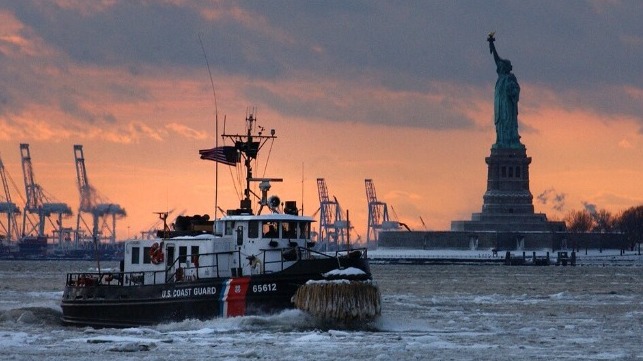USCG Changes Cutter Berthing to Open More Leadership Roles to Women

[By Daniel Henry, U.S. Coast Guard Sector New York]
When Chief Petty Officer Ryan Burger was installed as the officer-in-charge (OIC) of the 65-foot ice breaking tug Coast Guard Cutter Wire, he received a number of phone calls congratulating him on taking the reins of the venerable 60 year old cutter as his first command. One call, though, was a little different from the others. It was Senior Chief Petty Officer Ramona Mason, the Coast Guard’s enlisted women afloat coordinator within the Office of Enlisted Personnel Management (EPM), who had a question for him.
“I got a phone call from Senior Chief Mason and she asked if we could accept a female BM3 (Boatswains Mate Third Class) board, and obviously our answer was yes, of course we can! Then she had a follow up question - can you accept another female board as well?"
At that point Burger paused, and they talked about it for a while; they could have the person come aboard, but they didn’t have a rack available for them and would have to find a way to accommodate them.
His ultimate response? “Let us see what we can do.”
Women serving on one of the New York 65-foot cutters before was certainly not unheard of. In fact, the immediate previous OIC of the Cutter Line, Senior Chief Petty Officer Holly Campbell, as well as her executive petty officer (XPO), Chief Petty Officer Barbara Elkins, both served together as recently as 2020.
The difference would be that more junior female personnel would be able to be assigned, thanks to a Coast Guard-wide change in policy regarding assigning women to platforms previously unavailable to them, as well as a commitment from the service to arrange a berthing modification to the cutters. And with three “C-Class” 65-footers, which all possess an aft space used as an administrative office or berthing for the XPO, Sector New York was the perfect place to turn the idea into a reality.
“We’ve assigned women to these cutters in command cadre positions in the past, however, assigning a third class boatswains mate aboard is new,” Mason said. “For the first time, a woman in a non-command position has received orders to the Coast Guard Cutter Wire.”
To make the cutter berthing conversion a reality and get females aboard as soon as possible, the Sector Waterways Management team worked quickly with counterparts at headquarters and throughout the service to place two female racks in a space that formerly held a single fold out convertible bunk.
Petty Officer Third Class Hailey LaRue, a boatswains mate who reported to the Wire this past summer, immediately took note of both the greater responsibilities she gained, as well as the broadened learning opportunities. She said these opportunities weren’t available to her on the 87-foot cutter she served aboard as a non-rate in Port Angeles, Washington.
“I knew I wanted to go afloat out of A-school to get rated sea time so that it would help me in my future career,” LaRue said. “It’s smaller and it’s a tight knit crew; there are tons of learning opportunities on both deck and engineering side, so you’ll become a better-rounded individual in your [rating]. There are opportunities you’ll get here that you won’t necessarily get on a bigger cutter, where you’re focused on a specific area.”
For Singletary, who formerly served as a chief boatswain’s mate and OIC himself, the experience LaRue is gaining is critical for junior women to have expanded future leadership opportunities.
“Obviously for a boatswain mate (BM), you strive to be an officer in charge. To do that you need the experience, you need the career path of being a coxswain, a deck watch officer, and being in the command cadre as XPO,” Singletary pointed out. “Providing this mixed gender berthing gives those members the opportunity to start their careers out early. They get to lead as a BM3 or a BM2. Eventually that path will lead to XPO positions on the new waterways commerce cutters that are being commissioned in late 2024."
The cutter crew is now awaiting arrival of the second woman billeted at Mason’s request within the next few weeks.
The conversion and outfitting of the 65-foot ice breaking tugs is not the only platform receiving attention as part of the Coast Guard’s commitment to increasing opportunities for women to serve afloat. The Coast Guard has also authorized a structural conversion for a minimum of three 140-foot ice-breaking tugs.
“Many of our older cutters were built before women served on afloat platforms in the Coast Guard, at that time there wasn’t a need to consider accommodations for women,” said Mason. “Now that those cutters are being decommissioned and replaced by newer cutters, we are making berthing arrangements for women to serve as part of their permanent party crew.”
Daniel Henry is chief of communications and public affairs for United States Coast Guard Sector New York, the largest Coast Guard element in the nation. This article appears courtesy of Coast Guard News and is reproduced here in an abbreviated form. The original may be found here.
The opinions expressed herein are the author's and not necessarily those of The Maritime Executive.
